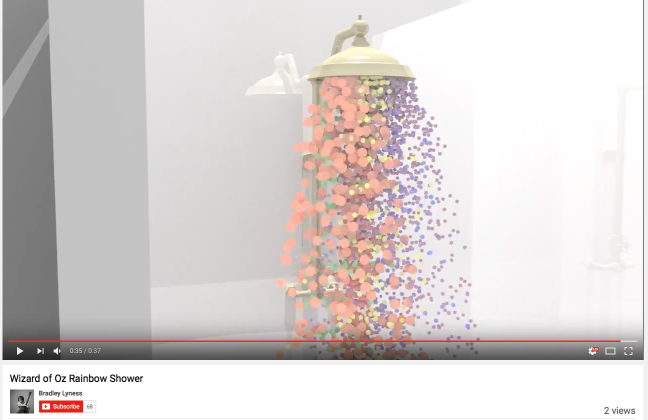08/02/17
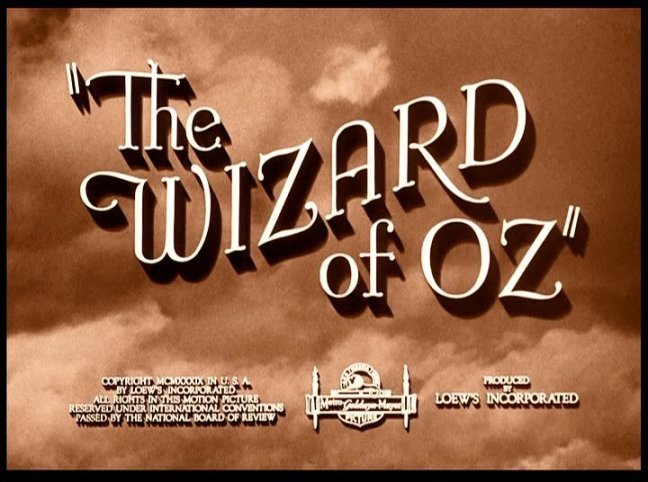
I am determined not to procrastinate on any of this. I am in a team consisting of Bradley, Caitlin and Emma. We ultimately need to come up with a schematic and an artefact based on the Wizard of Oz (Fleming 1939). Ok, first things first…. a to do list:
- See if the library has the DVD of the movie
- Research Schematic drawings (starting with Phil Campbell)
- Research the Movie itself
I think if our group could familiarise ourselves with the movie and start to get the creative juices flowing that will be a good start. I really want this artistic process to be filled with enjoyment and the type of relaxation that lends itself to creativity…. not laziness or conversely stress. Right. Watch this space.
After watching the film twice I came across this lovely documentary, narrated by Angela Lansbury: Wizard of Oz Documentary
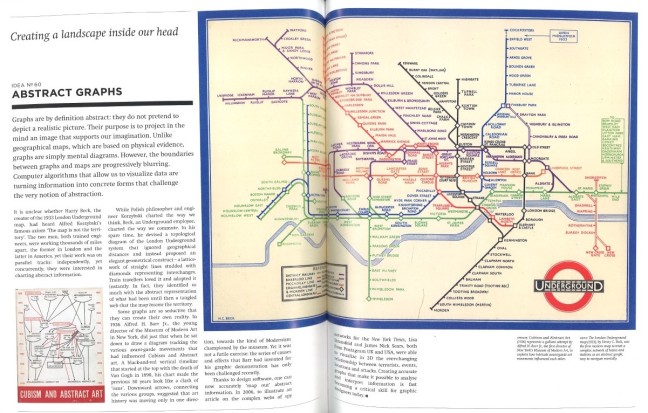
By the end of today i.e. now, I had a little schematic research done. I’ve looked at the work of Harry Beck, the designer of the original map of the London Underground. I also looked at ‘friend of the course’ and design legend Phil Campbell. His schematic diagram work on the Godfather game is going to very useful. I have also watched The Wizard of Oz (1939). I actually enjoyed it and even chortled at times! I had my file pad and pen at hand to jot down all the characters and their appearances in the scenes. As I watched and listened I also began jotting down inspirations for the artefact that we need to design. This has the potential to be fun.
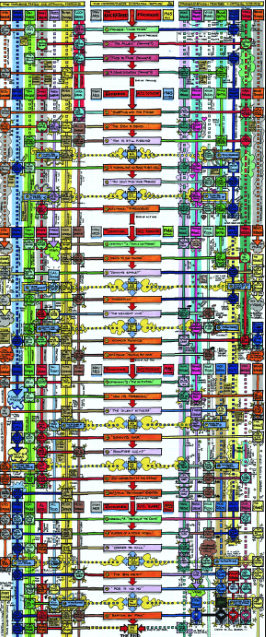
09/02/17
After a long day of life drawing and Maya tutorials I left CARL in search of bleach and wipes. The whiteboard was about to get some action. I spent a couple of hours making a scene summary of the movie from the notes I made last night (not unlike the above diagram). It is pretty dry to look at although it does chart the movements of main and secondary characters relatively consistently. I think the lecturers chose these films because there is a relatively simple flow of scenes and characters. I really need to have a visual record like this to crack on with the design process. After taking a few photos of the board (for weekend reference) I began writing various thoughts about the artefact.
An artefact: a usually simple object (such as a tool or ornament) showing human workmanship or modification as distinguished from a natural object; especially : an object remaining from a particular period
b : something characteristic of or resulting from a particular human institution, period, trend, or individual < … morality is an artifact of human culture, devised to help us negotiate social relations. — Michael Pollan>
c : something or someone arising from or associated with an earlier time especially when regarded as no longer appropriate, relevant, or important < … that over-simplified but eloquent quality that keeps Jefferson alive for us while Washington and Adams, his superiors in so many other respects, are artifacts of a quaint and lost world. — Jack Rakove>
(Merriam Webster, 1994)
Note to self: Monopoly boards, Cluedo boards, Tribal maps, treasure maps, Electrical schematics, Borough of Oz underground map?
12/02/17
This has been a thoroughly productive weekend. I motored away with this project. I transferred my white board schematic to my art pad with a few colouring concepts and amendments made. I looked at my book: 100 Ideas That Changed Graphic Design (Heller, Vienne 2012). I learnt more about Harry Beck and his contemporary Alfred Korzybski. Their visualisation of abstract ideas were revolutionary. Alfred H. Barr Junior would follow in their footsteps when attempting to graphically depict the movement of abstract art in the late 19th and early 20th Century. We can use elements from all these mens work.
I also looked at the Board games Cluedo and Monopoly. They came to mind as examples of playful mapping and icon design. Our schematic is going to require a fair few icons and the whole thing must be readable. I looked at how we could depict the various places in the movie with the help of a little Monopoly figure!
I also did some thought showering regarding the artefact. Our group hasn’t really met up yet and I want to be ready to contribute and get these tasks well under way by the end of this week. I had a lot of fun with my concepts and Bradley only added to it when he mentioned about the broom that the Wizard wanted could be stored in a specimen jar or an isolation tank!
Ok, this week meet with my team. Discuss how we are going to get this schematic complete, i.e. who’s designing the icons, who’s helping with the chart, what about alternative/hidden stories etc. Thought shower on the artefact. Tell the team that we must be ready to produce artefact for next Monday. Leave plenty of time to assemble the Pecha Kucha.

13/02/17
Today was a heavy going day. On top of all of this work we’ve got to think about storyboarding for next week. It’ll be alright. Today Bradley, Emma and myself managed to meet up and have a good old discussion about our schematic and artefact. It turns out we have a Wizard of Oz expert! Emma was brought up on the movie and knows it inside out! We had a fun talk about artefact concepts. I told her to do drawings for some of the icons needed and think about some fun hidden stories within the fabric of the story.
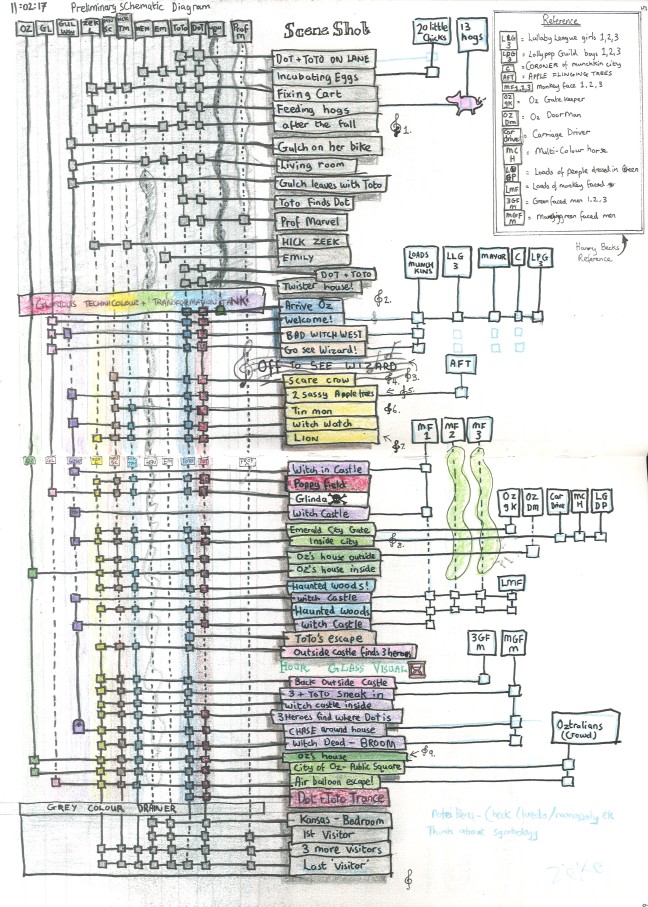
I’m still trying to figure out the nature of the diagram. I was also looking at some of the pioneers in pictography. Some names I’ve researched are as follows:
- Otto Neurath and Marie Reidemeister
- Arntz, Tschinkel and Bernath
- Rudolph modley
- Henry Dreyfuss
All designers are connected but it’s Neurath how is most widely accredited with inspiring modern information graphics.

14/02/17
Yesterday I looked at the key icons needed for our schematic. I think that there are various elements of the movie that can be depicted via the means of a pictogram and corresponding key. The key places of the movie will be represented:
- Kansas homestead (Ordinary world)
- The land of Oz
- The haunted woods
- The yellow brick road
- The poppy field
- The Emerald city
- The wizard’s house
- The witch’s castle
There will be a key for secondary and tertiary characters. These characters will be represented by initials in square boxes. We also need to chart the musical score of the movie. We could do this by inserting numbered treble clefs in at the beginning of a song then have a key to designate what song is being performed. Also a separate key for possible hidden stories. For example what exactly is going on with uncle Henry for the 50 odd scenes that he’s absent from? Or what are the flying monkeys 2 and 3 doing before appearing in the witch’s castle? I was thinking we could underlay another coloured track on these characters paths with a corresponding key to allude to these purely fun conjectures.
Bradley and myself have sat down today with the intention of bashing out a rough schematic on photoshop. We’re getting all the grunt work done here.
16/02/17
I decided to take a look at walking Dorothy through the ‘Hero’s Journey’. She fits in there like a square peg. I don’t know what I really think about this monomyth that Campbell espoused. Is it mostly faff?
I watched the movie last night over again with the pure intention of enjoying it. Mission accomplished. I started thinking in terms of artefacts. I really don’t want to be making something toe-curlingly obvious or boring. I find it hilarious that the Wicked Witch of the West leaves highly corrosive H2O lying around her house! She must be a real thrill seeker. A minor foresight? What about a Health and safety at Work Act for the Land of Oz? After all, think of all the hazards you might come across:
- Apple flinging trees
- Falling houses
- Water (deadly and corrosive to witch-folk)
- Electric Shock (from ruby slippers)
- Falling poop (flying monkeys)
- Opium poppy fields (do not operate flying brooms near or around)
- Asbestos snow (good for waking up, great for ending your life)
- Glinda the good witch (obnoxiousness levels critically high)
Another idea that popped to mind last night came when I heard that the munchkins were going to honour Dorothy by creating a bust after she rid Oz of the Wicked Witch of the East. It has all the makings of a young religion! How about an artefact based on the evolution of the cult of Dorothy?
- Statue
- Icon stained glass window
- Dorothy (Our lady of the crashing house) appears in a munchkins lollypop!
- Holy war artefacts?
What would be a fun medium? Find a glass blower and make my own glass bottle for toxic H2O? Carve a beautiful sculpture from a book? A 3D hologram on maya? Balsa wood model? A sculpture made from melted fox’s glacier mints? Ha, or jelly. Laminated paper?
17/02/17
Note to self, people seem to laugh at our warning labels idea (in a good way). What about loads of simple warning posters? Or a puppet made for the purpose of demonstrating safe navigation through the Land of Oz?
19/02/17
I spent the whole weekend working on possible designs for our warning notices. I feel what I’ve got so far is pretty fun and a strong candidate for the final artefact. I was thinking along the lines of Rudolf Modley’s work on the ISOTYPE symbols. It’s a real skill to graphically symbolise concepts via the most simplified images. I also looked at the ‘Dorothy worship’ concept again. I’ve actually always admired Jim Fitzpatrick’s iconic image of Che Guevara (not trying to butter up Conånn!). The original photo was taken by Alberto Korda on a Leica M2 with a 90mm lens. Fitzpatrick produced a stylised version of the image years later. I placed Dorothy’s visage in an image with a similar look. The idea being that the people of Oz came to see her as a revolutionary against the oppression of the wicked witches. Anyway, it’s still a concept. The rainbow shower might still be in the running also. Gianni from second year said that he knew how to produce the colour spectrum thing quite easily. Watch this space. This week we need to tidy up the schematic, add hidden adventure keys, scene keys and clear titles. We need to decide on an artefact, get decent design drawings done and then produce the thing. After this is done we need to get the Pecha Kucha together. The challenge here is getting all this done and juggle other projects at the same time.
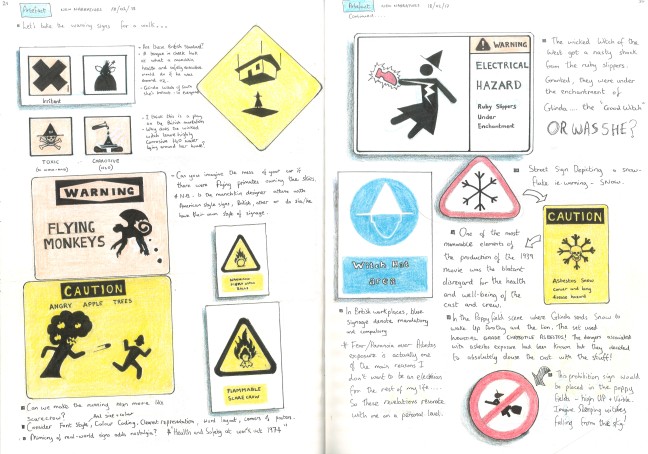
20/02/17
After class, Bradley and myself came to a decision. If we could find a decent rainbow spectrum effect on Maya, then the rainbow shower would be the artefact for us. Gianni from second year showed us how to get a rainbow light effect, however it was apparent that it didn’t quite capture the liquid illusion we hoped for. We will continue to look for a more appropriate means of conveying a liquid rainbow. I really like Bradley’s ‘specimen jar/isolation tank for the broom’ idea, so if the rainbow shower idea doesn’t work then this shall be the backup plan. It’s quite difficult saying goodbye to the ‘warning signs for Oz’ and ‘Cult of Dorothy’ ideas. There’s a real opportunity for some serious giggles with the novelty warning signs and I’ve done a fair bit of research for them. Them’s the brakes.
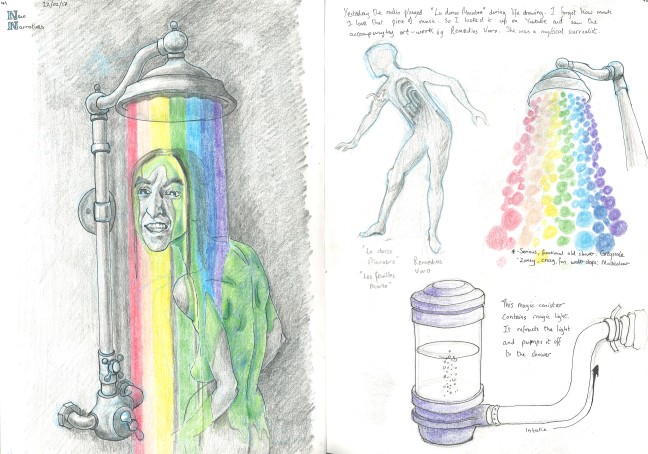
Right now it’s almost 22:00pm and I handed Bradley some rough elevations of a vintage shower. I drew the shower head, stalk, and taps (largely inspired by a shower design by Cynthia Van Elk ) ready for the big man to model it on Maya. It’s quite an elegant design that fits in to the 1930’s era well.

Conceptually the idea is based on the child-like misconception that the world and its peoples were in monochrome in the olden days. Watching retro television as a child, I was under this naive impression. In the movie we find the dreary, greyscale toned Kansas stands in stark contrast to the glorious technicolor of the Land of Oz.
At this point this team of two has the artefact well on the way to fruition and the bulk of the schematic is complete, so hopefully the Pecha Kucha should come together organically. There are a few amendments and additions I hope to make to the Schematic which I will do now. There are a few issues with the key that I want to resolve before signing off on it…..
21/02/17
Bradley and myself have been getting some animations on the go. Whilst he researched the production of the ‘rainbow cascade’ on Arnold, I animated his models. Fair enough, they were pretty simple animations consisting of a sequence where the tap for the multicolour/monochrome-flow moves to the left hand side position, then to the right hand side position. The other little animation was the intake faucet rotating in such a way as to suggest it opening. We ended the day at around 22:00pm by starting the render on a these animations.
22/02/17
I’m a little deflated right now. As I said this team should have been a group effort with the momentum of 4 people behind it. In reality Bradley and myself have done all of the work at all stages. I’m frustrated because we’ve got all the ongoing assignments to keep on top of and here I am taking a whole day to plan and assemble a Pecha Kucha. I’ve been looking at The Wizard of Oz through the eyes of Vogler again. I have to say I find this very boring. I’m constantly looking at this theoretical stuff when all I want to do is become a better artist. So that is what today is about. Getting some semblance of a presentation ready. Below my viewing of The Wizard of Oz (1939) through Vogler’s perspective.
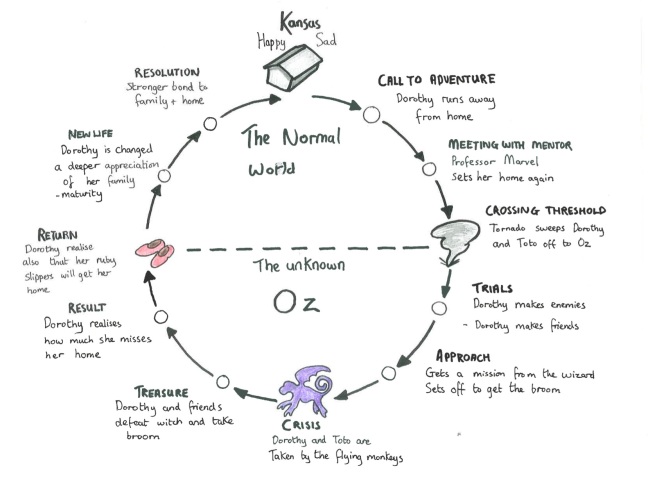
23/02/17
The Wonderful Wizard of Oz was written by L. Frank Baum in 1900. The original story of the little girl who wanted to go home but had the greater need to feel like she belonged there. The book contains many differences from the movie, some being:
- In the book the Land of Oz is a real place
- In the book the slippers are silver not ruby
- The book explains why the Scarecrow, Tinman and Lion desire there respective requests
- It is the Good Witch of the North who greets Dorothy to the Land of Oz
- The Wizard gives a makeshift brain, a silk heart and liquid courage
- The book is more violent (Tin man decapitates the heads of forty wolves! Scarecrow Breaks the necks of forty crows!)
- The book explains how the winged monkeys came under the bondage of servitude to the Wicked Witch of the East.
- In the poppy field it is the ‘Queen of the Field mice’ who saves the sleeping lion. Not asbestos snow!

When I learnt that the book describes four individual witches, I realised that is what was missing from the movie. I always found it strange that Glinda would give Dorothy her ruby slippers (her means home to Kansas) then send her on a pointless journey to a fraudulent wizard. The book makes more sense when you realise that Glinda only appears later to reveal to Dorothy the power of the slippers.
The three act structure of the story:
Little Dorothy cuts a lonely figure at the beginning of the story. She lives a dreary existence in the a backwater farm in the middle of nowhere. We learn that she is an orphan who lives with her Auntie and Uncle. She has a loyal companion in Toto (a sidekick dog who could be argued to be her sense of self) but the closest thing she has to friends is the three farm labourers Hickory, Hunk and Zeke. Everyone else on the farm seems to have a job or purpose. Dorothy comes across as a nuisance. She even dresses differently in her crisp clean outfit. Dorothy and her sidekick are the victims of injustice from Miss Gulch who seems to have in for the feisty pooch.
The movie can be described as having a three act structure. This means the movie is divided up into three parts consisting of:
- Act 1; The Setup
- Act 2; The Conflict
- Act 3; The resolution
Act 1 – the setup
In act one we get a sense of Dorothy’s normal life. She feels rather alienated by those closest to her and persecuted by her antagonist. We witness the inciting incident when we see Dorothy and Toto fleeing from Ms. Gulch and her attempt to have the dog destroyed. The story gets rolling and they hit the point of no return when they get caught up in the tornado. This is the pinch point, a threshold or point of no return. Dorothy and Toto are then whisked off to the magical world of Oz. She doesn’t have much of a choice other than going ahead with the mission of finding the Wizard who is ‘the only person who could possibly help her get home.’
Act2 – the conflict
As Dorothy sets off on her adventure she gradually meets new allies or friends with their own sub-plot objectives e.g. Scarecrow wants a brain. At this point our hero faces a few trials and obstacles such as the angry trees, the witches fireball and the climatic sleep inducing poppy field. All this builds the audience’s relief when finally they reach the City of Oz. She is led to believe she will be able to get home and all will be well, until she receives the surprise of being declined by the wizard. The hero is presented with another crossroads. Either she stays in Oz indefinitely or she confronts the witch and steals her broom. She chooses to go after the broom, no going back.
Act3 – the resolution
The hero and her crew find themselves facing more obstacles, overcoming trials until the climactic scene when the witch is slain. Loose ends are tied up back at the Emerald City and at this point Dorothy has come to the full realisation that there’s no place like home.
24/02/17
Today Bradley and I met up to check some of the renders. I have to say I’m really happy with the multi-colour water droplets. We decided on a less than realistic look for the rainbow flow. It adds to theme of contrasts in the artefact. We have a vintage, elegant and functional looking shower that emits a spray of fantastical technicolor droplets. Seriousness juxtaposed with the silly. The surrounding surfaces of the wall and ground are purposely textured in monochrome, in keeping with our original premise of a monochrome world.
So what’s the meaning behind this classic movie? Well the explicit meaning is; a little girl gets lost and needs to find her way back home. Boiled down it can’t be reduced to less than this.
The implicit meaning however is far more fragmented. There are hundreds of theories on the inner meaning of the story ranging from Political theory to individualistic interpretations. At its simplest level it is saying ‘often the things in life that we truly want are things that we already possess, we just need to realise it’. Dorothy didn’t realise that it was her home and family that meant the most to her, until it was revealed to her. She learns this through her exposure to external pressures in the form of malignant witches and a deceptive wizard. Likewise, the scarecrow wanted a brain to be intelligent and yet demonstrates that intellect is within him, brain or not. The Lion wanted courage and yet when the time came for him to face his fears, he rises to the occasion. The tin woodman wanted a heart and yet displayed splendid compassion without it.
The significance of the rainbow:
I’ve been looking at the scientific nature of rainbows, fascinating stuff. I’ll drop the pretence of pretending I understand it all and will fight the urge to regurgitate the info here. Here’s a great website I dipped into: Physic site
Did you know that all rainbow are in theory circular. In actuality the refracted light makes a circle, that’s usually broken visually by the horizontal plane of the earth.
Let’s have a quick rundown of mankind’s symbolic perception of the magnificent rainbow:
- Judeo-Christian: The eternal sign of God’s forgiveness and covenantal mercy (His war bow is no longer pointing at the earth)
- Greco-Roman: The path of Iris between Heaven and Earth
- Chinese: The slit in the sky sealed by the goddess Nuwa using stones of 5 different colours.
- Hindu: ‘Indradhanush’ or the ‘Bow of Indra (the god of lightning, thunder and rain)’
- Ancient Arabian: ‘Qaus Quzah’ or the ‘war bow of Quzah’
- Bengali: war bow
- Armenian: Belt of Tir (a Sun god)
- Norse: ‘Bifrost Bridge’ is a rainbow that connects the homes of the gods with the habitations of mankind
- Amazonian: They are associated with malignant spirits which cause skin problems and miscarriages
- New Age: Represent the 7 Chakras
As a motif for flags the rainbow has been used by the Inca territory in Peru, in the German peasants war (16th century) and by the Italians as a symbol of peace. Gilbert Baker used the rainbow pattern for his LGBT flag in 1978. Interestingly he was an openly gay activist originally from Kansas! Many people believe he took some inspiration from the ‘Somewhere over the rainbow’ song in the movie.
Technicolor
The movie has the glaring stylistic device of being filmed partly in black and white (later painted in Sepia tones), then partly in ‘technicolor’, using the new three strip colour method. It was a stylistic decision to portray Kansas this way, many point to the fact that L. Frank Baum alluded to this in the original book. He described the State of Kansas and even some of its inhabitants as grey. A very gaudy website about technicolour.
26/02/17
I came home this weekend with the intent of making a little trip to our local B&Q (other stores are available!). From early on in the artefact task I knew I wanted to at least attempt a tangible prototype of our rainbow shower. In my mind I had planned on sourcing bits and bobs to do this. The first port of call was the family farm and my late grandfather’s garage. It proved largely unfruitful as anything with any sculpting potential was rusted to the point of total corruption. I did find a bit of fuse wire which is some consolation. So as I browsed around my favourite emporium, it would be copper/steel pipes and plumbing accessories to be the most obvious candidate. I know copper is expensive stuff and so I was non committal when I saw tiny 8mm2 elbows and thin copper piping to be the cost of a weeks groceries! A tiny vintage shower prototype would have be ideal, however I wasn’t prepared to spend big on this. As a result I decided to focus on more of a conceptual sculpture that contains the nature of our lively rainbow cascade in contrast with the solid, sober nature of the shower head. The medium of choice turned out to be silicon adhesive, the bottom of an aluminium can and Skittles! Needless to say I was very tempted to ‘taste the rainbow!’
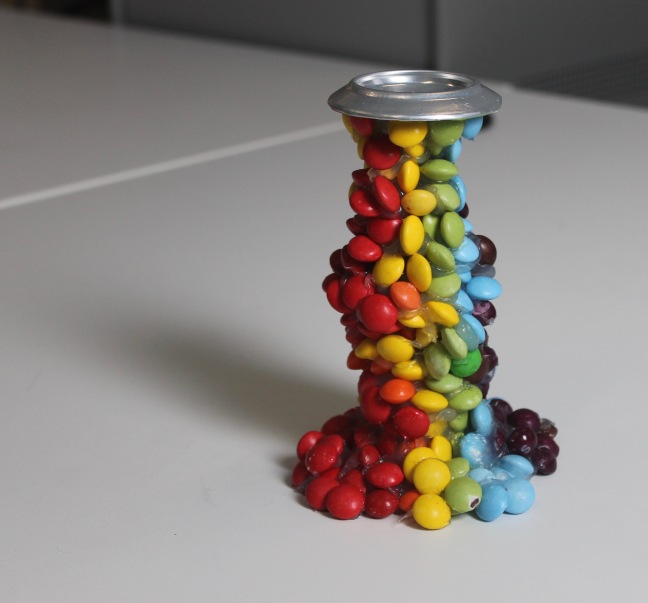
It was fun exercise that was completed in around 6 silicon drying stages. I kept in mind the order of colours in the refracted light spectrum, with a little artistic license being employed of course.
The silicon adhesive proved to be very forgiving and the Skittles were just the right consistency as to sit snugly in the tower of glue. I toyed with the idea of testing painted glass for our rainbow cascade, however I really like the opacity and clamour of the sweeties.
I am really happy with this artefact (being our animated model) credit goes to Bradley Lyness for his skilful Maya modelling, animating and rendering. I had a blast designing the shower and animating the taps. Anyway without further ado ladies and gentlemen….. I present to you our patented multicolour shower! See y’all somewhere over the rainbow.
